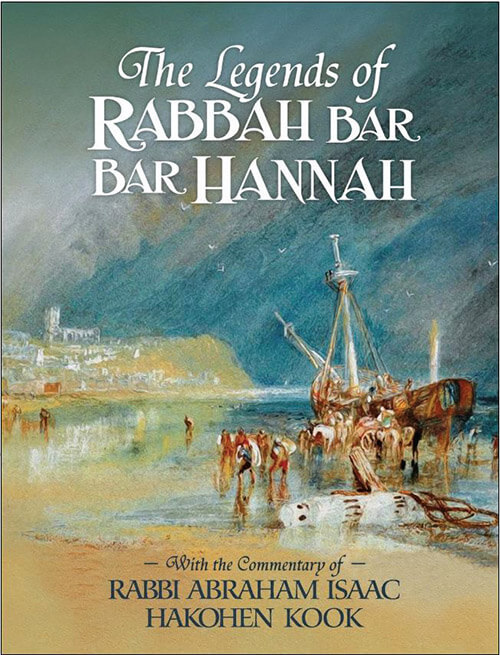
Highlighting: “The Legends of Rabbah Bar Bar Hannah with the Commentary of Rabbi Abraham Isaac Hakohen Kook,” by Bezalel Naor. Kodesh Press L.L.C. 2019. English. Hardcover. 354 pages. ISBN-13: 978-1947857117.
Rabbi Abraham Isaac Hakohen Kook is known for many reasons. He was one of the most outspoken Zionists of his age, a great lover of the Jewish people and one of the most influential philosophers of the 20th century. Despite his soaring popularity, many of his writings are still relatively obscure, especially in the English-speaking world. The new release of “The Legends of Rabbah Bar Bar Hannah: With the Commentary of Rabbi Abraham Isaac Hakohen Kook” by Rabbi Bezalel Naor is an astounding new work that brings Rav Kook’s interpretation of aggadot to the Anglophone world for the first time ever.
This work has three layers. First is the exotic and fanciful tales of Rabbah Bar Bar Hannah as they appear in tractate Bava Batra. These captivating stories, 15 in all, clearly invite interpretation. For example, the seventh legend reads, “One time, we were traveling on a ship and we saw a certain fish upon whose back sand had settled, and grass grew on it. We assumed that it was dry land and went up and baked and cooked on the back [of the fish] but when its back grew hot, it turned over. And were it not for the fact that the ship was close by, we would have drowned.”
The second layer is Rav Kook’s commentary on the 15 legends. It is astonishing that Rav Kook wrote this commentary when he was merely 25! More important than that, this is one of the few places that Rav Kook openly writes using technical kabbalistic terminology. While there are mystical ideas in his other works, it appears that later in life he eschewed referencing mystical concepts explicitly. “The Legends of Rabbah Bar Bar Hannah” is one of the few places where the reader can observe Rav Kook’s kabbalistic methodology on full display. Readers see Rav Kook interpret the legends symbolically, where water, dry land, fish and other objects are all interpreted in a non-literal fashion. Another great feature of the work is that it is based on the handwritten manuscripts of Rav Kook! This is opposed to all other Hebrew editions and commentaries that are based on other printed editions, into which many errors have crept.
Finally, the third major layer is Rabbi Bezalel Naor’s annotation, which is almost a super-commentary. Rabbi Bezalel Naor is one of the greatest interpreters of Rav Kook, and a master of both Torat ha-Nigleh and Torat ha-Nistar. Rabbi Naor’s annotation is essential because many of us are unfamiliar with the depth of the kabbalistic system; Naor is able to explain Rav Kook’s terminology so that is can be understood by a non-specialist, making it accessible to all without sacrificing depth. Anyone familiar with Rav Naor’s writings knows that his annotations run the gamut of Biblical, Talmudic, philosophical and kabbalistic writings. His annotations especially draw from earlier kabbalists like the Vilna Gaon, Rabbi Moshe Chaim Luzzatto, the Baal HaTanya and Rabbi Chaim of Volozhin, to name a few. Rabbi Naor masterfully weaves together these earlier masters alongside the interpretations of Rav Kook. The method of annotation is one of the reasons this book is truly special and unique.
The book also contains original artwork that corresponds to each of the 15 legends.
“The Legends of Rabbah Bar Bar Hannah” is a fascinating study of how aggadah has been seriously studied and interpreted by Rav Kook, one of the greatest minds Judaism has ever known. It is made all the more special by Rabbi Naor, for both translating and masterfully bringing the text to life. For anyone interested in aggadah, Kabbalah, Rav Kook or Jewish philosophy, this work will surely captivate.













